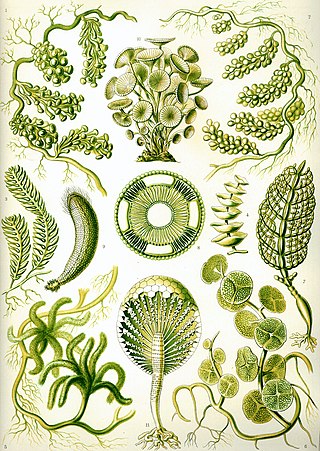
Chlorophyta is a division of green algae informally called chlorophytes.

A lichen is a hybrid colony of algae or cyanobacteria living symbiotically among filaments of multiple fungi species, along with yeasts and bacteria embedded in the cortex or "skin", in a mutualistic relationship. Lichens are the lifeform that first brought the term symbiosis under biological context.

Cladonia rangiferina, also known as reindeer cup lichen, reindeer lichen or grey reindeer lichen, is a light-coloured fruticose, cup lichen species in the family Cladoniaceae. It grows in both hot and cold climates in well-drained, open environments. Found primarily in areas of alpine tundra, it is extremely cold-hardy.

The Cladoniaceae are a family of lichen-forming fungi in the order Lecanorales, comprising about 560 species distributed amongst 18 genera. This family is one of the largest among lichen-forming fungi and is globally distributed, from Arctic tundra to tropical rainforests, favouring humid environments while being intolerant of arid conditions. Molecular phylogenetics has significantly advanced the understanding of their complex taxonomic history, revealing intricate evolutionary relationships and leading to a refined classification. Notable members include reindeer moss and cup lichens of the genus Cladonia, which consist of about 500 species and forms a significant part of the diet for large mammals in taiga and tundra ecosystems.
Vernon Ahmadjian was a distinguished professor at Clark University in Worcester, Massachusetts. He specialized in the symbiosis of lichens, and wrote several books and numerous publications on the subject.

Bracteacoccus is a genus of green algae, the sole genus of the family Bracteacoccaceae. It is a terrestrial alga commonly found in soils, from the tropics to the poles.

Paradoxia is a genus of microscopic green algae, in the family Coccomyxaceae. It is found in freshwater habitats as phytoplankton worldwide, but species are rare.

Pediastrum is a genus of green algae, in the family Hydrodictyaceae. It is a photoautotrophic, nonmotile coenobial green alga that inhabits freshwater environments. The name Pediastrum comes from the Greek root words pedion, meaning "plane", and astron, meaning "star", referring to its overall shape.

Trebouxia is a unicellular green alga. It is a photosynthetic organism that can exist in almost all habitats found in polar, tropical, and temperate regions. It can either exist in a symbiotic relationship with fungi in the form of lichen or it can survive independently as a free-living organism alone or in colonies. Trebouxia is the most common photobiont in extant lichens. It is a primary producer of marine, freshwater and terrestrial ecosystems. It uses carotenoids and chlorophyll a and b to harvest energy from the sun and provide nutrients to various animals and insects.

Chlorotetraedron is a genus of green algae, in the family Neochloridaceae. The name may also be written as Chlorotetraëdron. It is found as freshwater plankton or in soil.
Korshikoviella is a genus of green algae in the family Characiaceae.
Symbiochloris reticulata is a species of green alga in the Trebouxiales. It is a known as a photobiont with several lichen species, like Lobaria pulmonaria, but also as a free-living soil alga as well. Phylogenetic analysis of rRNA sequence data revealed that the species shares a sister group relationship with two other green algae that lack motile stages, Chlorella saccharophila and C. luteoviridis.

Pilophorus acicularis, commonly known as the nail lichen or the devil's matchstick lichen, is a species of matchstick lichen in the family Cladoniaceae.

Symbiosis in lichens is the mutually beneficial symbiotic relationship of green algae and/or blue-green algae (cyanobacteria) living among filaments of a fungus, forming lichen.
Bracteamorpha is a genus of green algae in the order Sphaeropleales, and is the only genus in the family Bracteamorphaceae. It contains a single species, Bracteamorpha trainorii.
Trebouxia decolorans is a widespread and common symbiotic species of green alga that is found in association with different species of lichen-forming fungi. Some lichens in which it is the photobiont partner are Xanthoria parietina and Anaptychia ciliaris.
Trebouxia arboricola is a symbiotic species of green alga in the family Trebouxiaceae. Described as new to science in 1924, it is usually found in association with different species of lichen-forming fungi and has a broad global distribution.
Trebouxia gelatinosa is a common symbiotic species of green alga in the family Trebouxiaceae. Formally described as new to science in 1975, it is usually found in association with different species of lichen-forming fungi.
Asterochloris is a genus of green algae in the family Trebouxiophyceae. It is a common photobiont in lichen, occurring in the thalli of more than 20 lichen genera worldwide. Asterochloris is distinguishable from the morphologically similar genus Trebouxia, primarily due to its deeply lobed chloroplast, the placement of the chloroplast along the cell's periphery before the initiation of zoospore or aplanospore formation, and its tendency to primarily reproduce asexually through the production of aplanospores.
Trebouxia flava is a species of green alga in the family Trebouxiaceae. First described in 1975 by Patricia Ann Archibald, it features spherical cells containing multiple nuclei and a single chloroplast with a small pyrenoid. The species is characterized by its distinctive dull-shiny, sulphurous yellow cultures, which differ from the typical shiny yellow-green appearance of most other Trebouxia species. It can reproduce both through motile zoospores and non-motile aplanospores, and was originally isolated from the foliose lichen species Physconia pulverulenta.










